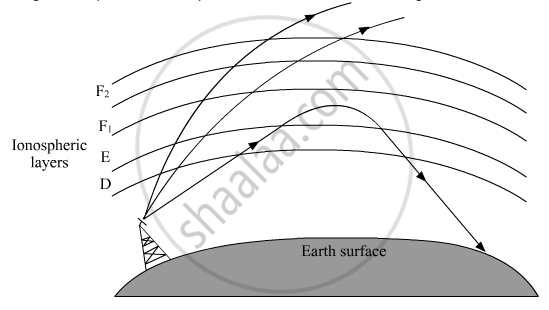Advertisements
Advertisements
Question
Describe briefly, by drawing suitable diagram, the sky wave ?
Solution
In the frequency range from a few MHz up to 30-40 MHz, long distance communication can be achieved by ionospheric reflection of radio waves back towards the earth. This mode of propagation is called sky wave propagation. The ionosphere consists of large number of ions or charged particles due to ionisation in the presence of ultraviolet rays. The degree of ionisation varies with height. At a certain height, there occurs a peak of ionisation density which acts as a reflector of certain range of frequencies. This phenomenon is shown in the figure below:

APPEARS IN
RELATED QUESTIONS
(i) Which mode of propagation is used by shortwave broadcast services having frequency range from a few MHz upto 30 MHz? Explain diagrammatically how long distance communication can be achieved by this mode.
(ii) Why is there an upper limit to frequency of waves used in this mode?
Explain why ground wave communication mode cannot be used for long-distance communication using high frequencies
Four nuclei of an element undergo fusion to form a heavier nucleus, with release of energy. Which of the two – the parent or the daughter nucleus – would have higher binding energy per nucleon?
An em wave is travelling in a medium with a velocity `vecv =vhati` Draw a sketch showing the propagation of the em wave, indicating the direction of the oscillating electric and magnetic fields.
What do you mean by skip distance?
The length of half wave dipole at 30MH2 is
The wavelength of electromagnetic wave employed in space communication very over a range of
The radio wave of frequency 300 MHz to 3000 MHz be.long to
Three waves A, B and C of frequencies 1600 kHz, 5 MHz and 60 MHz, respectively are to be transmitted from one place to another. Which of the following is the most appropriate mode of communication ______.
Two waves A and B of frequencies 2 MHz and 3 MHz, respectively are beamed in the same direction for communication via sky wave. Which one of these is likely to travel longer distance in the ionosphere before suffering total internal reflection?
